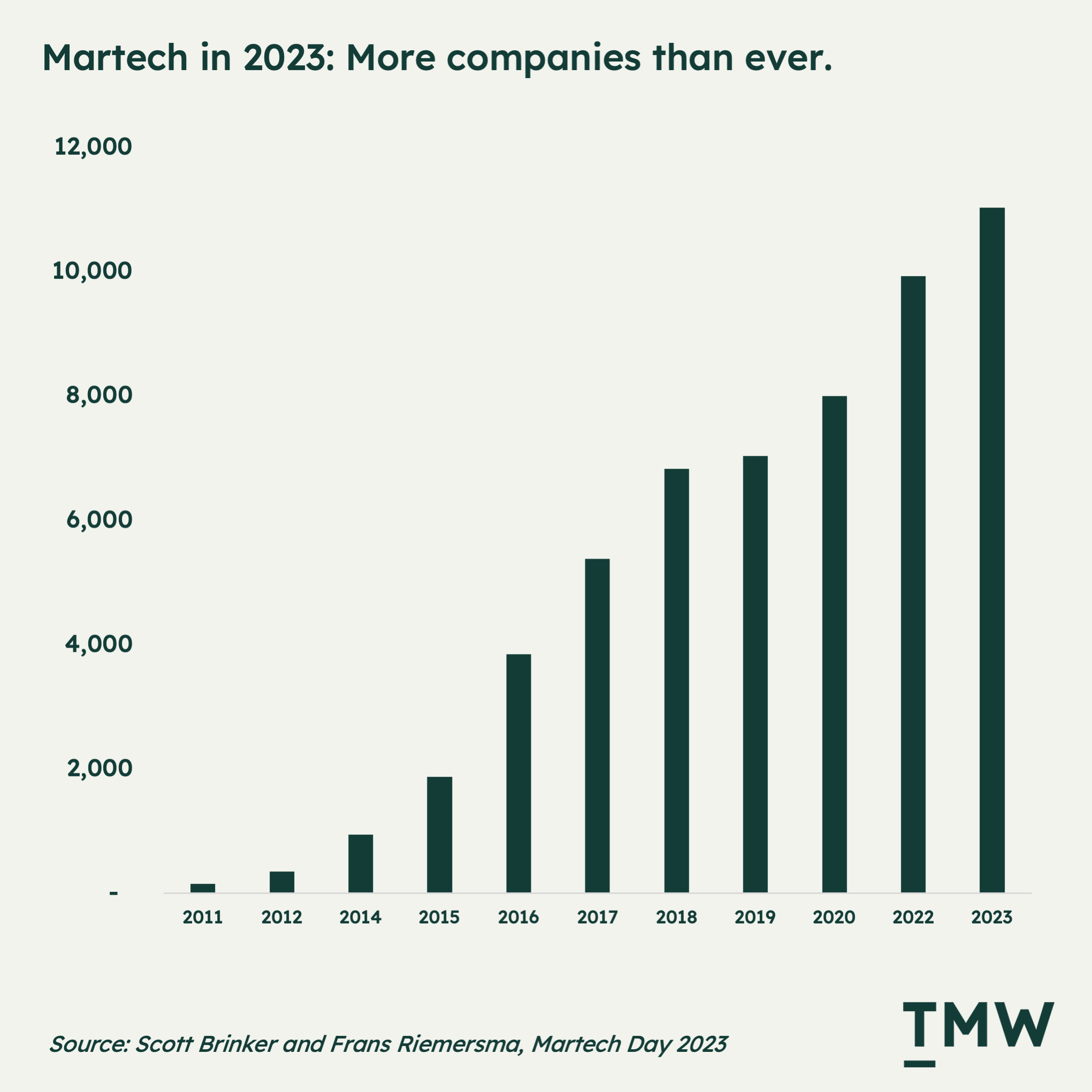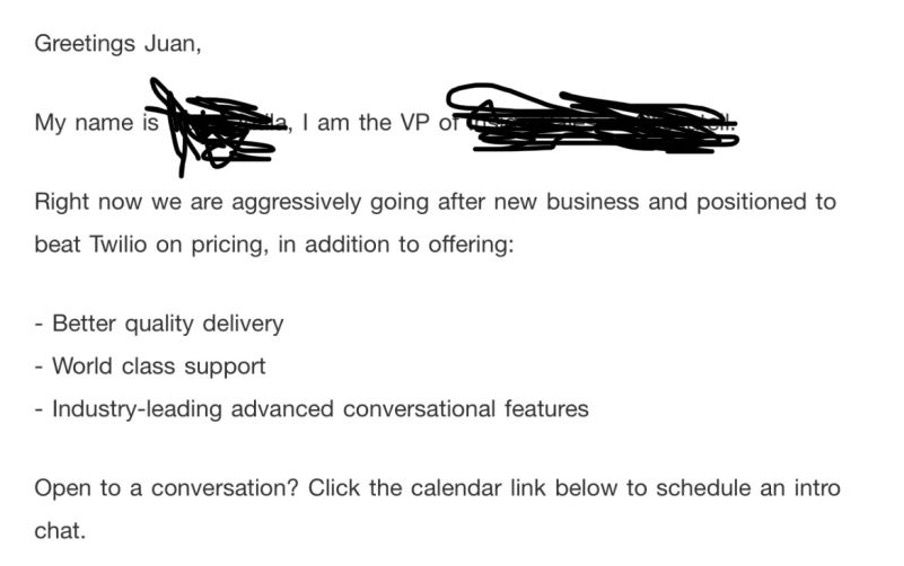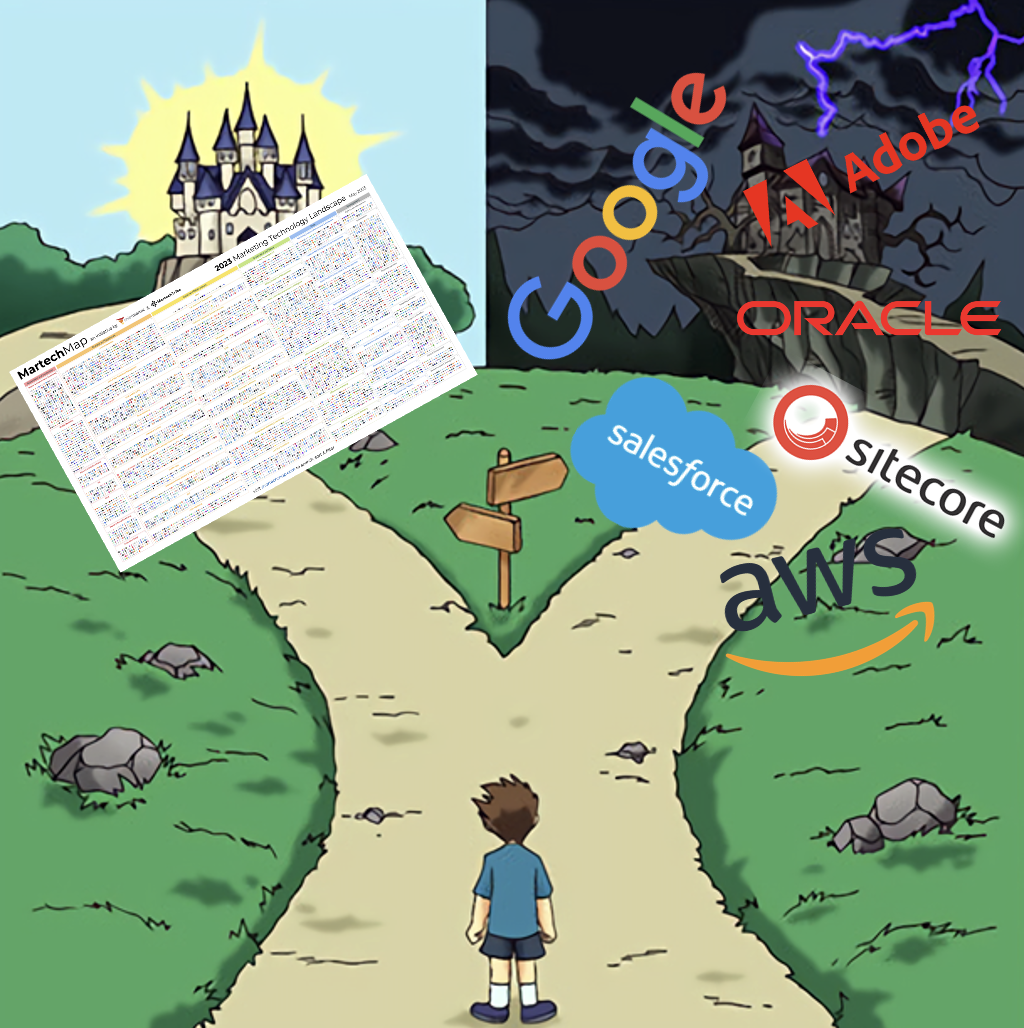TMW #124 | The unbearable weight of new Martech
Welcome to The Martech Weekly, where every week I review some of the most interesting ideas, research, and latest news. I look to where the industry is going and what you should be paying attention to.
👋 Get TMW every Sunday
TMW is the fastest and easiest way to stay ahead of the Martech industry. Sign up to get the full version delivered every Sunday for this and every TMW, along with an invite to the TMW community. Learn more here.
The unbearable weight of new Martech
Jerusalem is a city that’s famous for building on top of its own history. It’s a place that’s been destroyed and rebuilt twice, making it an interesting and frustrating place to find archaeological artifacts. The city has layers of buildings built on top of buildings.

Martech has grown again in 2023. Scott Brinker and Frans Riemersma for Martech Day this week have released the updated Martech map which tracks the global growth of tech companies directly or indirectly offering products for marketers. This time the number of companies has jumped to more than 11,000. Another year of growth, like every single year before it. Adding layer upon layer upon layer.

But the reception to the Martech map this year is quite different from previous years. More people than ever are asking if there’s a limit here, that it’s not possibly sustainable to have so many companies competing for marketing budgets with marketers having to muster up the skills and discipline to make this technology work in business.
People are asking if Martech is becoming an unsustainable cluster, that this industry is ripe for generative AI to replace most of what’s there, that this year’s Martech map proves there is a need for consolidation, that marketing has lost its way as a tools management discipline and that it’s the reason for why marketing is getting worse and not better.
There’s a shift here, and the industry is starting to notice it. Each year new companies are added, which means more apps standing on the shoulders of the internet and all the open-source services and massive corporations it provides for marketers to find and convert customers. It’s easy to think that there are too many products, not enough customers, and far too many options.
And while the category continues to grow, it’s still small in comparison to other spaces like finance, health, and education technology categories. Even HR tech has more companies than Martech! This should tell us one thing – there could be far more growth waiting for this category as it matures or that Martech is reaching its outer limits in what it can do for business. Perhaps it’s both. But there are two challenges that could prevent Martech from continuing its growth: capital and skills.

When the tide goes out
It was legendary investor Warren Buffet who once said, “It’s only when the tide goes out that you discover who’s been swimming naked.” In 2023 Capital is becoming a bigger problem for Martech companies and over the past twelve months, there’s been a lot of naked folks out there frolicking nude in the water.
We’ve never seen so many layoffs across the industry over the past 12 months from hundreds of private and public tech companies - some as large as Salesforce. We’re at the tail end now of the Covid correction. During the gold rush of 2020 and 2021 we’ve seen a lot of growth as brands worldwide rushed to adopt technologies in the face of the entire population shifting to online methods to buy groceries, to finding a therapist to connect with their friends.
That famous “ten years in three months” McKinsey chart making the rounds during the pandemic turned out to be fiction as now, the tide is going out and people are doing the things that mostly made sense offline like buying groceries, finding a therapist, or connecting with friends.
Multiple sources and from a variety of angles suggest Martech is actually shrinking in value as consumer behaviors revert back to the pre-pandemic trend line. Nielsen is saying in their latest report that Martech investment is declining across all regions, with APAC hit the hardest. Globally around 50% of companies are planning to up their spending in Martech in 2023.

It’s not as bad as it could be, but still. There’s only so much budget to buy new Martech, and fewer buyers mean fewer start ups. If we look at the Martech map from the perspective of diminishing budgets, we have founders building tech for audiences of blank stares and empty budgets.
As we continue down the path of spending contraction, there will be more desperate attempts to gain market share, more hacks and tactics, and more grandiose promises of riches for brands that adopt their tech, leading to overworked BDRs, customer success teams, and product marketers. And we’ll start to get emails more cold emails like this:

The size of the prize is getting smaller too. Luma has been tracking the valuation multiples over the years, and during the pandemic, valuations for Martech ballooned to 17 times their revenue, but during 2022 it started to decline. Now it’s normalizing to around 4% – a little less than half of the first quarter of 2023.
If you’re after the big pot of gold at the end of the Martech rainbow, that pot was much bigger two years ago than now. This raises an interesting question: is it still lucrative to build B2B software-as-a-service for marketers?

We need to look at both effort and outcome to answer this question. This year’s Martech map had 689 companies removed. Assuming that some of these were failed companies, it’s a tiny percentage overall, but it’s also about a third of the 1,795 newly discovered companies this year. The barriers to building software for marketers are lower than ever as no code tools come into the market, and ecosystems enable niche use cases to quickly build up a customer base. This means growth – more companies, and decline – more failures.
But the interesting problems in the Martech space rely on deep technical excellence and creativity. And if you’re going to exit a company at a 4x revenue multiple, is investing half a decade’s worth of time to develop something new worth it? Right now, probably not. You’re better off drop shipping stuff from China.
This is the baffling thing about the increased growth in net new Martech in 2023 is that the technology is increasingly represented by derivative copycats or niche segmentation of software solutions. I do wonder how many SEO agencies need a lead management platform or how many healthcare companies need a chatbot. Of course, it makes sense to tailor an existing technology to a specific role or industry type, but there’s only so much value in doing this.
The Martech Map isn’t really a view of industry health. It’s a view of companies entering a category. So the question is, are more companies better than less for the industry as a whole? In one sense, yes – more companies mean more people shooting their shot to find commercial opportunities, and more brains working on problems usually dramatically increase the probability of exponential innovation. This is partly due to people trying to out-compete each other. But it's primarily due to more brain power to solve problems that haven’t otherwise couldn’t be solved.
Scott Alexander looks at a popular framework for thinking about scientific and technological innovation – Moore’s Law. And suggests that the reason why there’s this increasingly exponential growth is not due to the fundamental nature of the tech itself. It’s just more people working on the problems.
“This is the standard presentation of Moore’s Law – the number of transistors you can fit on a chip doubles about every two years (eg grows by 35% per year)... But BJRW have a pessimistic take. There are eighteen times more people involved in transistor-related research today than in 1971. So if in 1971 it took 1000 scientists to increase transistor density 35% per year, today it takes 18,000 scientists to do the same task. So apparently the average transistor scientist is eighteen times less productive today than fifty years ago. That should be surprising and scary.”
More brains may not mean more technology that genuinely makes marketers more efficient, create more value for brands and become more creative. But it certainly helps. But only if the incentives align. Increasing the density of transistors could lead to a lucrative career. Increasing the features in a marketing automation platform does not.
All the gear and no idea
I have this friend that I grew up with. We still talk occasionally, but when we met in our early 20s, we were living in very different living situations. He lived with his wealthy family. I lived in my own zero-bedroom flat. He was at university, I was working in kitchens. But somehow, we bonded and became good friends.
But there was something interesting about him, that I think carries in our current season of Martech. You see, he was a big musician. He had all the gear, dozens of guitars. The latest pedals and amps. And he played all the time. We spent a bit of time playing together. But beyond that, he never wrote his own songs or did much more with his collection. I remember he used to play a lot of ACDC covers.
Ascend2 has recently pulled together a report talking about this. Almost 80% of marketers are using less than 50% of their Martech stack. This is also supported by research from Gartner that says only 42% of marketing technologists are using the full gamut of their Martech capabilities, which has decreased from 2020. Similar statistics can be found in Demand Metric’s Martech utilization survey, with half of the responses saying they have a large amount of unused Martech.
If a variety of independent research projects agree, then the insight is pretty clear. Marketers have all the gear (Martech) but no idea (skills) to actually implement and use the technology to further their brand’s growth.

And I think this has to do with the skills gap. Research from Arktic Fox – an Australian-based firm – is tracking the skills gap in Martech, and recently released their annual report on Martech capabilities in brands. And their perspective data and analytics skills continue to be a challenge for marketers along with commercial acumen (the asking the CMO for money skill), Martech strategy and critical thinking. A separate McKinsey report is now saying that 70% of digital transformations have failed, yet another hallmark in the story of brands failing to use technology for marketing and sales.
My hypothesis for this is that marketers aren’t really in the game of building the tech capabilities of a company. Rather they are there to grow market share, find revenue opportunities, make customer’s experiences better, and drive a message to market.
Tech isn’t something that marketers proactively are using. It’s stimuli that marketers react to. That’s why we see bright shiny thing syndrome so often. If it’s Nike experimenting with NFTs, or ecommerce brands implementing chatbots in 2017, McKinsey saying the Metaverse is worth $5 trillion in value, or Buzzfeed using ChatGPT to write its content. These are all just stimuli for bored (and often lazy) marketers. This isn’t a proactive, deliberate approach to building the technological capabilities of a brand so it can better compete in a digital world. It’s just screwing around with dumb JPEGs and VR goggles. Big difference.
This is the ‘no idea’ part of marketing. One of the challenges with a growing Martech category is that there’s just more diversity within each category to learn. We’re spoiled for choice, and the temptation to buy new Martech to do mediocre things with it. But is anything of real value really created? Are brands growing as a result of a smart application of the right tech to a strategy?
It’s incredibly rare to find people who have the tenacity to use technology deliberately in marketing. Those who are avoiding copying and pasting use cases from a vendor or letting a consultant tell them what to do and instead are finding their own insights and building strategies that actually match the unique situation of the brand they work in. It’s the difference between playing ACDC covers in the basement and Ed Sheeran releasing a hit single. The gear doesn’t matter insomuch as the idea.
Scott Brinker helpfully points out in his Martech day keynote that Marketing Ops is a growing category of technologists for the marketing department with the majority of companies being able to see real value from people working in these roles. These are the folks who are translating goals into use cases, planning for capabilities, managing tech debt, integrating apps, and deprecating useless tech. So perhaps Marketing Operations could be a salve for an industry struggling under the weight of its own complexity. Let’s hope so.
New Foundations
We have a very interesting situation in the Martech industry in 2023. There are more than a thousand newly discovered companies across the landscape, yet there’s a big pullback in spending, valuations are down, there’s an overwhelming lack of making use of the tech, and a big skills gap.
Because of this, I think we’re entering two pathways for marketing technology. One of consolidation or diversification. Consolidated tech to simplify the complexity of using a variety of solutions or increased variety and choice. My argument is that diversification will be more important to the future of the category.

Consolidation could cause the collapse of highly aligned categories in Martech. It will create fewer options, but greater simplicity for consumers. Companies like ClickUp and Intuit are trying to do this by offering a variety of features under one house. As mergers and acquisitions slow down, however, this is unlikely to happen at any dramatic scale.
Barry Schwartz, the author of The Paradox of Choice, describes the problem of more options in a crowded marketplace, saying: “Unfortunately, the proliferation of choice in our lives robs us of the opportunity to decide for ourselves just how important any given decision is.” Fewer choices usually mean faster outcomes. And there’s a good argument here for Martech to become more consolidated.
However, the more likely path for Martech is diversification, which has its own challenges if it is to be the main way Martech will grow. But the challenge here is that more companies will mean more competition across the more lucrative axis of Martech.
If everyone is promising to deliver omnichannel customer experiences, simplify analytics, or to solve your marketing funnel problems, this will make it harder to categorize technology. The choice paradox is real and should be acknowledged. But another way to think about it is that there are always going to be a few really innovative and helpful technologies in a category, and the rest will be close to useless. This means larger hay stacks to wade through, but with potentially more needles to find.
If Martech is to continue to grow in its diversity and variety, it will need two things: New ideas and new channels. Like the Jerusalem of today, most of Martech is built on top of old channels for customers to access products and services. Social media gave us almost 600 software products, and the ability to send email has enabled more than 1,000 companies to build valuable products. And even though we’ve seen in recent years the growth of new paradigms for things like TikTok as a new social media channel, it’s still firmly in the category of social media, and marketers approach TikTok like they would Instagram – it’s just another social channel.
As I’ve argued in the first TMW essay of the year, ‘2023 and the era of invention’, Martech is functioning on ancient foundations:
“We need the tinkerers, the explorers, and the inventors to bring novel ideas, fresh inspiration, and most importantly, new foundations for how we interact on the web. Going back to the example of Thomas Rutherford’s: he avoided commercialization, despite owning the inventions that lead to society-changing technology because he saw that the end of the commercial path only leads to entropy.”
We have so many new companies, but so few new principles for how online marketing should work. My hope is that in the roaring 20s of Martech, we find new foundations because in the end, we cannot iterate ourselves to the next breakthrough; it requires an entirely new way to think about the role of technology and how marketers use it to grow brands and better satisfy their customer.
Right now, Martech feels like it’s creaking under its own weight of ever-increasing iterations on top of ancient foundations. And with every industry, there will be a time when growth slows, stops, and reverses in the other direction. Perhaps this is what’s needed for new breakthroughs to come into market, because I don’t know how many more pitches from yet another email marketing tech start-up I can handle.
Stay Curious,
Make sense of marketing technology.
Sign up now to get TMW delivered to your inbox every Sunday evening plus an invite to the slack community.
Want to share something interesting or be featured in The Martech Weekly? Drop me a line at juan@themartechweekly.com.
